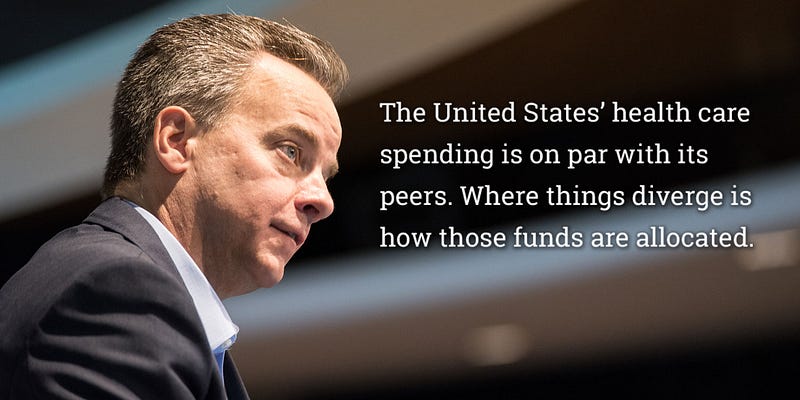Reimagining the Future of America’s Health Care System
The amount the U.S. spends on health care is on par with peer countries, but many in America are getting sicker while costs continue to rise.

By Adrienne Dawson
Dr. Mark McClellan agrees that iPads, air travel, and endless cable channels are great, but what people really value, he says, are longer and better lives. We want “the time to enjoy all of those things.”
The health care industry is responding. Worldwide increases in productivity in the health care system exceed the value of productivity increases of every other sector of the economy combined. But McClellan, senior policy advisor for Dell Medical School, points out that as productivity increases, so must the amount of money budgeted to pay for medical services, treatments, and therapies. Case in point, the U.S. government spends money on three main budget categories: social security, health care — and last, says, McClellan, “everything else.”
McClellan, MD, Ph.D., also serves as the director of the Margolis Center for Health Policy at Duke University and is the former head of the FDA and Centers for Medicare and Medicaid Services.
“Health care spending was 1 percent of GDP in the ’70s, it’s 5 percent of GDP today, and it’s on track according to the Congressional Budget Office to be 8 to 9 percent of GDP over the next 20 years,” he says.
“Just for perspective, the $600 billion we’ll spend on defense and homeland security is about a third less than is budgeted this year for my former agency, the CMS.”
Divergence in Population Outcomes
When it comes to health care in the U.S., McClellan emphasizes that the problem isn’t the amount spent. “The one constant in U.S. macroeconomic policy over the last 40-plus years is that when there’s been a choice between spending more on health care and spending more on just about any other programs, health care wins.”
The problem, he says, is in the distribution of funds.
Compared to 34 other nations in the Organisation for Economic Cooperation and Development (OECD), the United States’ health care spending is on par with its peers. Where things diverge is how those funds are allocated. “In the OECD, for every dollar spent on health care, about two dollars are spent on social services,” McClellan explains. Conversely, the U.S. spends about half as much on social services as it does for traditional health care programs.
As a result, we’re witnessing a divergence in population health outcomes. That means that even though people value longer and better lives, there’s an increase in mortality rates related to substance abuse, violence, suicide, cardiovascular disease, diabetes, and cancer. These things had been trending downward for the last century in developed nations, he says, but are now on the rise among certain U.S. demographic subsections, particularly white, middle-aged, low-to-middle-income Americans.
“The big story with premature death,” McClellan stresses, “are behavioral issues and social and environmental factors, the things that are more likely to be addressed by those other types of programs that have consistently been squeezed down in federal and state spending over the last 30 or 40 years.”

Fee-for-Value, Not Fee-for-Service
But along with the unceasing and often contentious debates — and stalemate — surrounding the Affordable Care Act is how to keep moving forward to address these very coverage issues given increasing health care costs. McClellan says that’s why more interest needs to be taken in addressing the value of care.
McClellan and National Academy of Medicine President Victor Dzau recently released a study that looks beyond policy debates to improve the nation’s health care system. A key element, he says, is moving from a fee-for-service model to a fee-for-value approach.
But as new biomedical advancements become available to treat diseases from HIV and hepatitis to cancer, the costs for those treatments rise. They’re more valuable — they lead to longer and better lives — but they’re also more expensive. The opportunity, he says, is for improving how those treatments are delivered. For many patients, using home health services, telemedicine, and more social service support would not only be more effective, it would also be cheaper.
“For those with more limited means or complex conditions, it isn’t so much the health care access that’s the root cause of the health problem, it’s things like access to housing or access to support services for behavioral health or substance abuse problems or other things that typically occur outside of the traditional health care setting.” — Mark McClellan
The challenge is that in our traditional health care system, those forms of care aren’t reimbursed. McClellan advocates moving to a fee structure that pays health practitioners for achieving the desired health outcome, not simply for ordering a test or scan. That gives clinicians the freedom to make decisions that are in the best interest of the patient. They’re able to make treatment options available that are often less expensive and more effective, all while being compensated for achieving the ultimate goal: Giving people longer and better lives.
Dr. Mark McClellan spoke at The University of Texas at Austin as part of the Texas Enterprise Speaker Series on April 14, 2017. To hear more, watch the video below.
Originally published at www.texasenterprise.utexas.edu on May 3, 2017.
http://www.texasenterprise.utexas.edu/2017/05/02/health-care/future-health-care-McClellan


